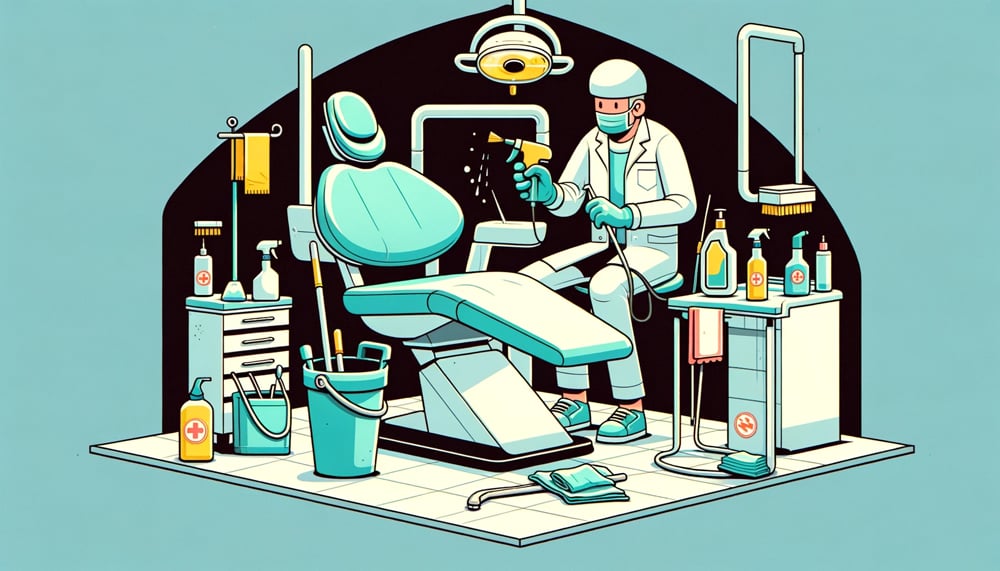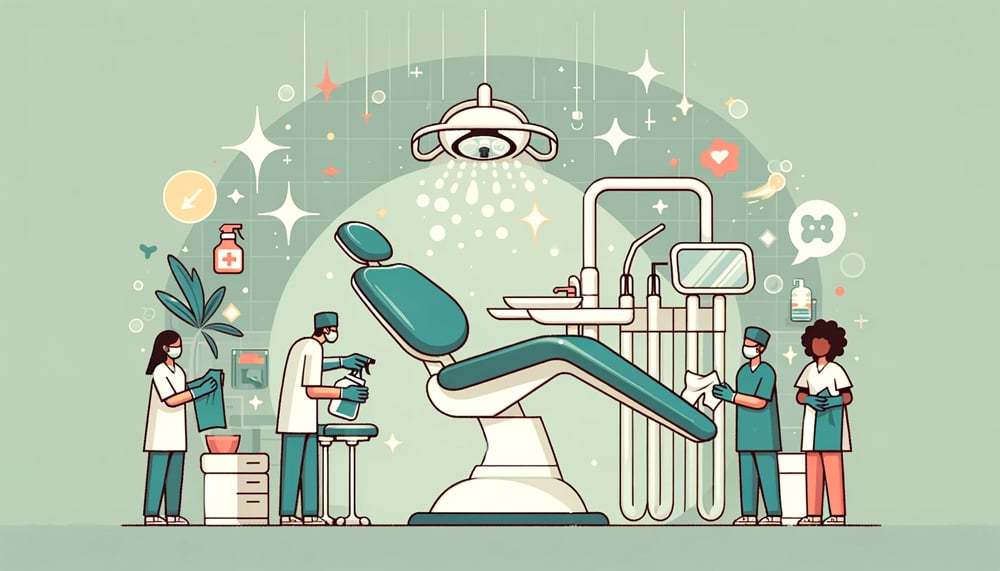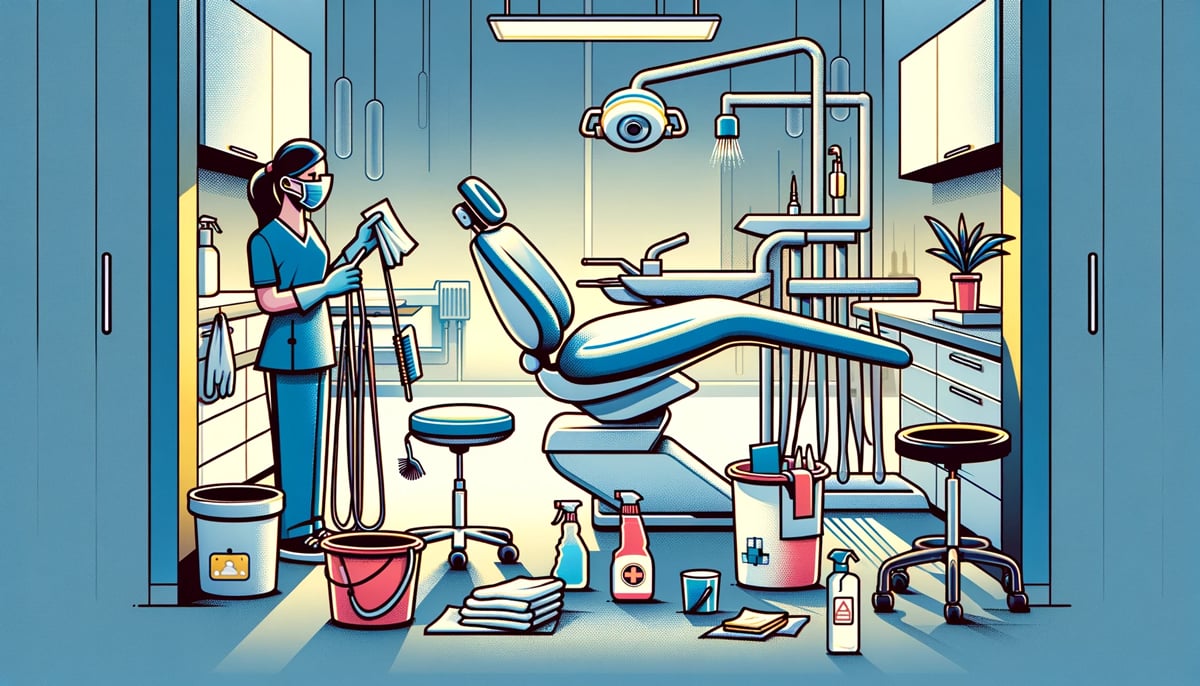I understand the profound impact cleanliness has on a dental practice. This article will guide you through maintaining the highest standards of hygiene, focusing on one of the most crucial aspects – cleaning dental chairs.
The Importance of Cleanliness in Dental Practices
In the world of dentistry, cleanliness isn’t just about appearance; it’s a cornerstone of patient safety and trust.
A study by the American Dental Association highlights that patients rate cleanliness as a key factor when choosing a dentist.
The dental chair, being the focal point of dental treatments, harbors various microorganisms, potentially leading to cross-contamination.
The implications of poor hygiene practices in dental settings are far-reaching. They not only risk the health of patients but also impact the reputation of the practice.
Hence, a rigorous and effective cleaning protocol for dental chairs isn’t just a recommendation; it’s a necessity.
Understanding Dental Chair Contamination

Dental chairs are exposed to a myriad of contaminants daily. Saliva, blood, and other bodily fluids are commonplace, making these chairs a breeding ground for bacteria, viruses, and fungi.
The Journal of Dental Research published a study revealing that certain bacteria can survive on surfaces like dental chairs for days, increasing the risk of nosocomial infections.
Understanding these risks is the first step towards effective cleaning. The type of contaminants and their potential dangers guide us in selecting the right cleaning agents and techniques.
Also read Dental Chair Repair Services
Step-by-Step Cleaning Guide

An effective cleaning process is methodical and thorough. Let’s break it down into manageable steps:
Pre-Cleaning Preparation
Before diving into the cleaning process, proper preparation is vital. Gather all necessary supplies, including gloves, masks, EPA-registered disinfectants, and cleaning cloths.
Ensure the cleaning agents are suitable for dental chair materials to avoid damage.
Cleaning Solutions and Techniques
Choosing the right cleaning solution is crucial. Opt for EPA-registered disinfectants known to be effective against a broad spectrum of pathogens.
Follow the manufacturer’s instructions for dilution and application. Use gentle, non-abrasive cloths to avoid damaging the chair’s surface.
Post-Cleaning Procedures
After cleaning, ensure the chair is thoroughly dried and inspected for any missed spots.
Preparing the chair for the next patient involves a final check for functionality and comfort, ensuring every aspect of the patient experience is optimal.
Common Mistakes to Avoid
Common mistakes in cleaning dental chairs include using overly abrasive cleaners that can damage surfaces and neglecting hard-to-reach areas where pathogens might lurk.
Another mistake is inconsistent cleaning schedules, leading to fluctuating hygiene standards.
Implementing a Regular Cleaning Schedule
Consistency is key to maintaining cleanliness. Implement a schedule that includes end-of-day deep cleaning and between-patient sanitization.
Tailor this schedule to your practice’s specific needs, considering patient volume and staff availability.
Legal and Compliance Considerations
Abiding by legal and compliance standards is non-negotiable. Familiarize yourself with OSHA regulations and CDC guidelines for infection control in dental settings.
Regular training for staff on these protocols ensures compliance and safety.
Conclusion
Effective cleaning protocols for dental chairs are essential for patient safety, trust, and the overall success of a dental practice.
By understanding the risks, following a thorough cleaning guide, and implementing a consistent schedule, dental professionals can ensure the highest hygiene standards.
FAQs about Dental Chair Cleaning Protocols
-
What are the best disinfectants to use on dental chairs?
Explore EPA-registered disinfectants that are effective against a broad range of pathogens and safe for dental chair materials.
-
How often should dental chairs be cleaned?
Learn about recommended cleaning schedules, including end-of-day deep cleaning and between-patient sanitization.
-
Can improper cleaning damage dental chairs?
Understand the risks of using abrasive cleaners and the importance of selecting the right cleaning agents to avoid damage.
-
What are common cleaning mistakes in dental practices?
Discover frequent cleaning oversights in dental practices, such as neglecting hard-to-reach areas and inconsistent cleaning schedules.
-
How do cleanliness standards impact patient trust in a dental practice?
Find out how maintaining high cleanliness standards in your dental practice can significantly boost patient trust and safety.
-
Are there specific legal requirements for cleaning dental chairs?
Get insights into the legal and compliance aspects of dental chair cleanliness, including OSHA regulations and CDC guidelines.
-
What should be included in a dental chair cleaning protocol?
Delve into the essential elements of an effective dental chair cleaning protocol, from pre-cleaning preparation to post-cleaning procedures.
-
How does chair material affect cleaning protocols?
Learn about the impact of different chair materials on cleaning techniques and the selection of appropriate cleaning agents.


